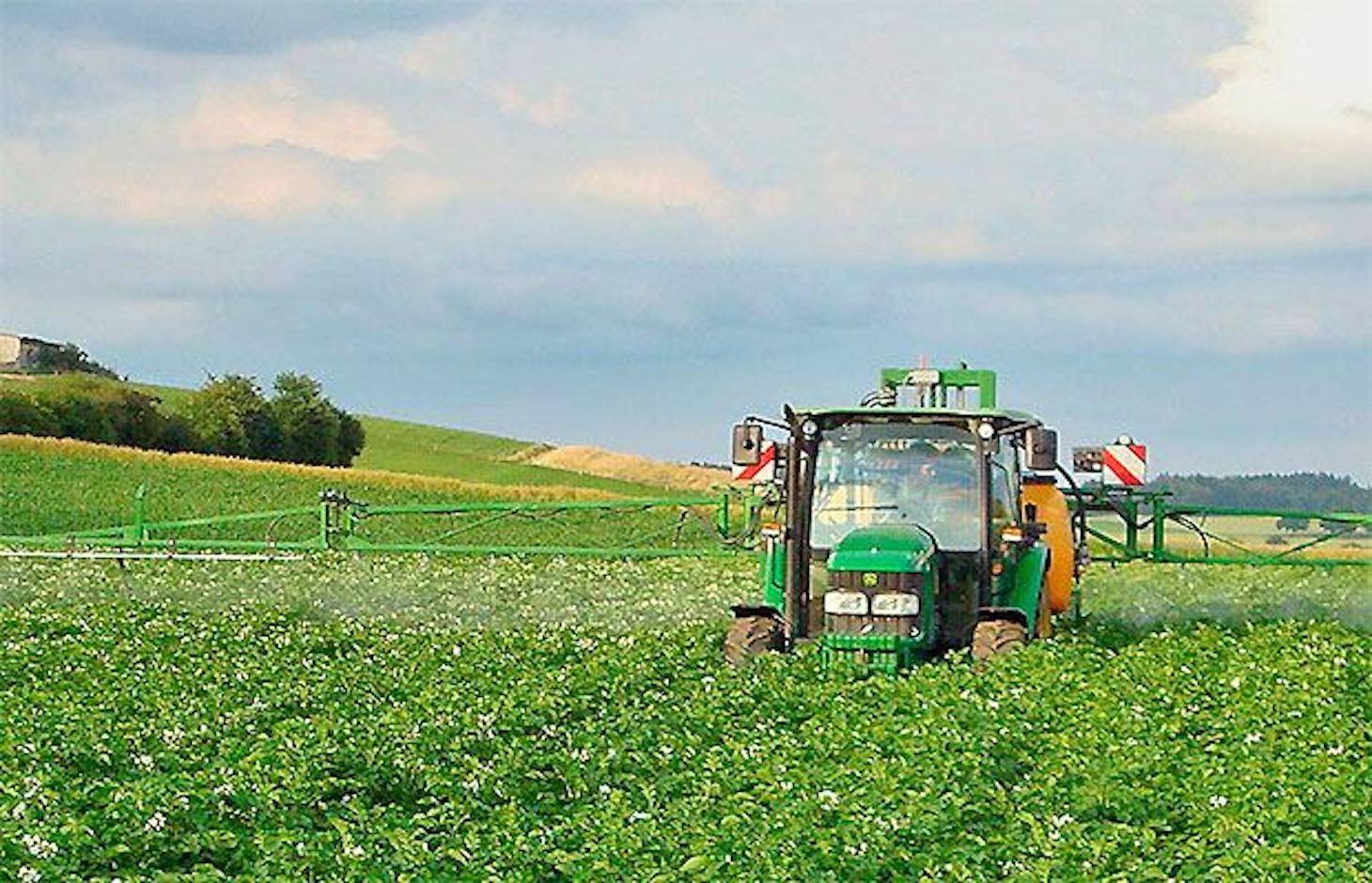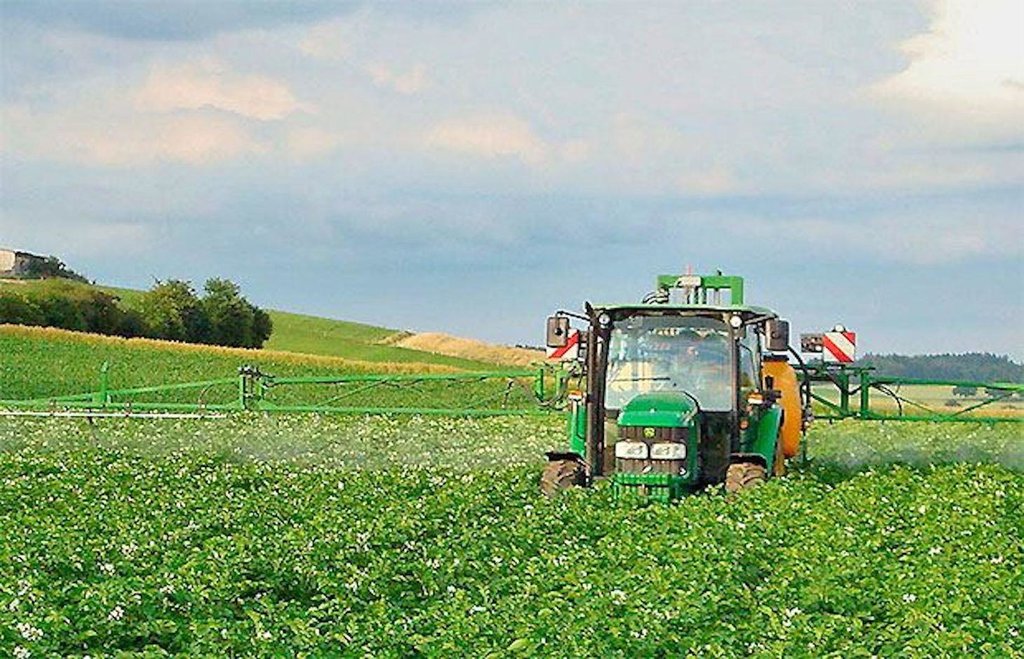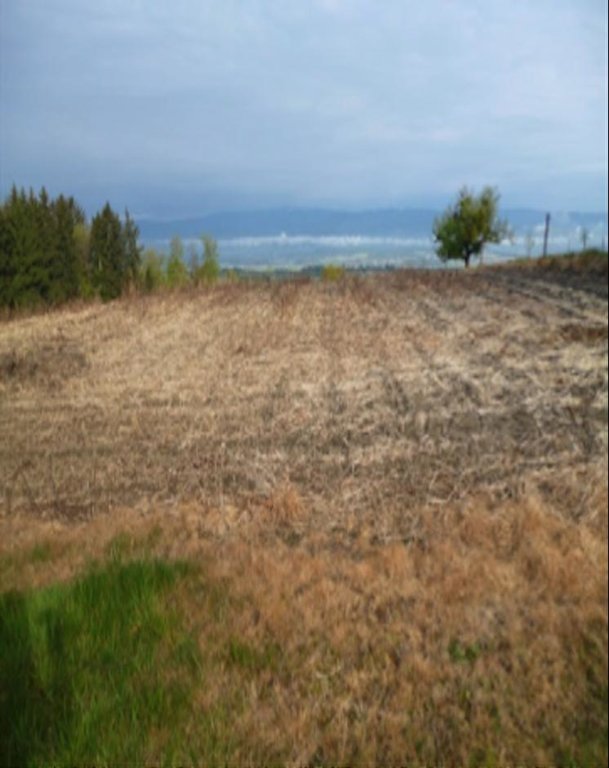Minimization of herbicide application in conservation agriculture [สวิตเซอร์แลนด์]
- ผู้สร้างสรรค์:
- การอัพเดท:
- ผู้รวบรวม: Deborah Niggli
- ผู้เรียบเรียง: –
- ผู้ตรวจสอบ: Fabian Ottiger, Alexandra Gavilano
Herbizideinsatz-Minimierung bei Feldern unter Direktsaat
technologies_1259 - สวิตเซอร์แลนด์
ดูส่วนย่อย
ขยายทั้งหมด ย่อทั้งหมด1. ข้อมูลทั่วไป
1.2 รายละเอียดที่ติดต่อได้ของผู้รวบรวมและองค์กรที่เกี่ยวข้องในการประเมินและการจัดเตรียมทำเอกสารของเทคโนโลยี
ชื่อของโครงการซึ่งอำนวยความสะดวกในการทำเอกสารหรือการประเมินเทคโนโลยี (ถ้าเกี่ยวข้อง)
Preventing and Remediating degradation of soils in Europe through Land Care (EU-RECARE )ชื่อขององค์กรซึ่งอำนวยความสะดวกในการทำเอกสารหรือการประเมินเทคโนโลยี (ถ้าเกี่ยวข้อง)
CDE Centre for Development and Environment (CDE Centre for Development and Environment) - สวิตเซอร์แลนด์1.3 เงื่อนไขการใช้ข้อมูลที่ได้บันทึกผ่านทาง WOCAT
ผู้รวบรวมและวิทยากรหลักยอมรับเงื่อนไขเกี่ยวกับการใช้ข้อมูลที่ถูกบันทึกผ่านทาง WOCAT:
ใช่
2. การอธิบายลักษณะของเทคโนโลยี SLM
2.1 การอธิบายแบบสั้น ๆ ของเทคโนโลยี
คำจำกัดความของเทคโนโลยี:
Through experience with herbicide application the land user learned that there are possibilities to minimize the amount of herbicide application to fields.
2.2 การอธิบายแบบละเอียดของเทคโนโลยี
คำอธิบาย:
The land user interviewed has an experience of nearly 30 years with the application of herbicide to his fields. Through this time he learned that there are ways to reduce the amount of herbicide and thereby conserve soil and nature against this aggressive pesticide. There are different factors to consider to reduce the herbicide application such as time of the day to bring out herbicides or time of the year. For example there is less herbicide needed the earlier in the morning it is applied to the field.
Purpose of the Technology: There are two main purposes of the technology. The fist is to protect crops and to not damage them with great amounts of herbicides. Thereby, also environment as a whole and especially waters are protected because there is always a part of herbicides washed out of soils and into waters. The second aim is more economically. As the effectiveness of the application of herbicides is worse in spring than in autumn, it should be prohibited by law to use herbicides in spring. On the other hand, land users should be allowed to use herbicides for a longer time in autumn because crops tend towards dormancy. Thereby, not only the amount of herbicides applied to a field can be reduced but the land user is also saving money.
Establishment / maintenance activities and inputs: The establishment and maintenance of the technology requires first of all a great deal of knowledge. To receive the desired target situation there are many points to be discussed of the current situation with herbicide application. One point is the free pass which enables land users with a basic education to practice pest management even if they do not know what a pest management gun is and how it is used. A solution to this problem of lack of knowledge is seen by the land user through the structural change in agriculture. Companies providing spraying services are more efficient and tidy than the land user can be.
Natural / human environment: The technology helps protecting the environment and waters from pollution through washed out herbicides. This must always be kept in mind when discussing about the amount of herbicides. Some land users do not trust a smaller amount of herbicides to be as effective as the standardized one. But this overthinking must now be made because it is until today not sure what side effects herbicides have to the human and natural environment.
2.3 รูปภาพของเทคโนโลยี
2.5 ประเทศภูมิภาค หรือสถานที่ตั้งที่เทคโนโลยีได้นำไปใช้และได้รับการครอบคลุมโดยการประเมินนี้
ประเทศ:
สวิตเซอร์แลนด์
ภูมิภาค/รัฐ/จังหวัด:
Bern
ข้อมูลจำเพาะเพิ่มเติมของสถานที่ตั้ง :
Oberbottigen
ระบุการกระจายตัวของเทคโนโลยี:
- กระจายไปอย่างสม่ำเสมอในพื้นที่
If precise area is not known, indicate approximate area covered:
- 0.1-1 ตร.กม.
2.6 วันที่การดำเนินการ
ถ้าไม่รู้ปีที่แน่นอน ให้ระบุวันที่โดยประมาณ:
- 10-50 ปี
2.7 คำแนะนำของเทคโนโลยี
ให้ระบุว่าเทคโนโลยีถูกแนะนำเข้ามาอย่างไร:
- ด้วยการริเริ่มของผู้ใช้ที่ดินเอง
ความคิดเห็น (ประเภทของโครงการ เป็นต้น) :
Society required an overthinking of traditional pest management techniques over the last years. The land user started individually with his tests. But also in politics there were some attempts to reduce herbicides in agriculture. Third, the farmer's association works together with the local government of Bern on solutions for reducing herbicides which could be applied nationwide.
3. การจัดประเภทของเทคโนโลยี SLM
3.2 ประเภทของการใช้ที่ดินในปัจจุบันที่ได้นำเทคโนโลยีไปใช้

พื้นที่ปลูกพืช
- การปลูกพืชล้มลุกอายุปีเดียว
จำนวนของฤดูเพาะปลูกต่อปี:
- 2
ระบุ:
Longest growing period in days: 120Longest growing period from month to month: May to AugustSecond longest growing period in days: 60Second longest growing period from month to month: August to October
แสดงความคิดเห็น:
Major land use problems (compiler’s opinion): The major land use problems are erosion by water through heavy rainfall events and therefore loss of soil. Regarding the technology there is also the problem of the extensive use of herbicides and its inappropriate application. This can lead to damages to the following crop, chemical resistance and pollution of waters.
Major land use problems (land users’ perception): The area is likely to be affected by erosion as the main problem. Therefore, cultivation must be adapted to prevent soil erosion by water. The land user is also convinced of a pollution of waters through different human-induced reasons such as the inappropriate and ineffective use of herbicides.
3.4 การใช้น้ำ
การใช้น้ำของที่ดินที่มีการใช้เทคโนโลยีอยู่:
- น้ำฝนร่วมกับการชลประทาน
3.5 กลุ่ม SLM ที่ตรงกับเทคโนโลยีนี้
- การรบกวนดินให้น้อยที่สุด
- การจัดการศัตรูพืชและโรคพืชแบบผสมผสาน (รวมถึงเกษตรอินทรีย์ด้วย)
3.6 มาตรการ SLM ที่ประกอบกันเป็นเทคโนโลยี

มาตรการจัดการพืช
- A3: การรักษาหน้าดิน
- A4: การรักษาดินชั้นล่าง
แสดงความคิดเห็น:
Main measures: agronomic measures
Type of agronomic measures: retaining more vegetation cover, mulching, mineral (inorganic) fertilizers, zero tillage / no-till, minimum tillage
3.7 รูปแบบหลักของการเสื่อมโทรมของที่ดินที่ได้รับการแก้ไขโดยเทคโนโลยี

การกัดกร่อนของดินโดยน้ำ
- Wt (Loss of topsoil): การสูญเสียดินชั้นบนหรือการกัดกร่อนที่ผิวดิน

การเสื่อมโทรมของดินทางด้านเคมี
- Cp (Soil pollution): มลพิษในดิน

การเสื่อมโทรมของน้ำ
- Hp (Decline of surface water quality): การลดลงของคุณภาพน้ำที่ผิวดิน
แสดงความคิดเห็น:
Main type of degradation addressed: Cp: soil pollution, Hp: decline of surface water quality
Secondary types of degradation addressed: Wt: loss of topsoil / surface erosion
Main causes of degradation: soil management (Use of herbicides in the past that are forbidden today have polluted soil and the environment substantially.), discharges (point contamination of water) (discharges of herbicides from agricultural fields into water bodies)
Secondary causes of degradation: Heavy / extreme rainfall (intensity/amounts) (not a main cause because the busy season of pesticides is in spring and heavy rainfalls mainly occur in autumn)
3.8 การป้องกัน การลดลง หรือการฟื้นฟูความเสื่อมโทรมของที่ดิน
ระบุเป้าหมายของเทคโนโลยีกับความเสื่อมโทรมของที่ดิน:
- ป้องกันความเสื่อมโทรมของที่ดิน
แสดงความคิดเห็น:
Main goals: prevention of land degradation
4. ข้อมูลจำเพาะด้านเทคนิค กิจกรรมการนำไปปฏิบัติใช้ ปัจจัยนำเข้า และค่าใช้จ่าย
4.1 แบบแปลนทางเทคนิคของเทคโนโลยี
ข้อมูลจำเพาะด้านเทคนิค (แบบแปลนทางเทคนิคของเทคโนโลยี):
Technical knowledge required for field staff / advisors: high (Vital role of agricultural advisor, who must be neutral and not a salesman.)
Technical knowledge required for land users: high (The land user always needs to have the best knowledge which must also be up to date. Therefore, he depends on a competent agricultural advisor. The knowledge he gained is transferred to his employees.)
Main technical functions: improvement of surface structure (crusting, sealing), improvement of topsoil structure (compaction), improvement of subsoil structure (hardpan), increase of groundcover
Retaining more vegetation cover
Material/ species: mulch of previous crop remains
Mulching
Material/ species: previous crop remains
Mineral (inorganic) fertilizers
Material/ species: different types of herbicide
Zero tillage / no-till
Material/ species: machine with pesticide machine
Remarks: technological requirements such as individual nozzle switching, inside cleaning and wash
4.2 ข้อมูลทั่วไปเกี่ยวกับการคำนวณปัจจัยนำเข้าและค่าใช้จ่าย
อื่นๆ หรือสกุลเงินประจำชาติ (ระบุ):
Swiss Franc
If relevant, indicate exchange rate from USD to local currency (e.g. 1 USD = 79.9 Brazilian Real): 1 USD =:
1.0
4.3 กิจกรรมเพื่อการจัดตั้ง
| กิจกรรม | Timing (season) | |
|---|---|---|
| 1. | Establishment of a washing area | |
| 2. | Buying a special nozzle machine |
4.4 ค่าใช้จ่ายของปัจจัยนำเข้าที่จำเป็นสำหรับการจัดตั้ง
| ปัจจัยนำเข้า | หน่วย | ปริมาณ | ค่าใช้จ่ายต่อหน่วย | ค่าใช้จ่ายทั้งหมดต่อปัจจัยนำเข้า | %ของค่าใช้จ่ายที่ก่อให้เกิดขึ้นโดยผู้ใช้ที่ดิน | |
|---|---|---|---|---|---|---|
| แรงงาน | Labour | ha | 1.0 | 15.0 | 15.0 | 100.0 |
| อุปกรณ์ | Tools | ha | 1.0 | 3500.0 | 3500.0 | 100.0 |
| อุปกรณ์ | Infrastructure: Washing area | ha | 1.0 | 1000.0 | 1000.0 | 100.0 |
| ค่าใช้จ่ายทั้งหมดของการจัดตั้งเทคโนโลยี | 4515.0 | |||||
| Total costs for establishment of the Technology in USD | 4515.0 | |||||
แสดงความคิดเห็น:
Life span of product (washing area): Lifetime
4.5 การบำรุงรักษาสภาพหรือกิจกรรมที่เกิดขึ้นเป็นประจำ
| กิจกรรม | ช่วงระยะเวลา/ความถี่ | |
|---|---|---|
| 1. | begin of herbicide application (not including market gardening) | start of vegetation period/ March - end of May |
| 2. | after first harvest stubble treatment with total herbicide | August/September |
| 3. | after second harvest again application of herbicides until 10th of October (end of herbicide application) | September/October |
4.6 ค่าใช้จ่ายของปัจจัยนำเข้าและกิจกรรมที่เกิดขึ้นเป็นประจำที่ต้องการการบำรุงรักษา (ต่อปี)
| ปัจจัยนำเข้า | หน่วย | ปริมาณ | ค่าใช้จ่ายต่อหน่วย | ค่าใช้จ่ายทั้งหมดต่อปัจจัยนำเข้า | %ของค่าใช้จ่ายที่ก่อให้เกิดขึ้นโดยผู้ใช้ที่ดิน | |
|---|---|---|---|---|---|---|
| แรงงาน | Labour | ha | 1.0 | 90.0 | 90.0 | 100.0 |
| อุปกรณ์ | Machine use | ha | 1.0 | 90.0 | 90.0 | 100.0 |
| อุปกรณ์ | Tools | ha | 1.0 | 60.0 | 60.0 | 100.0 |
| ปุ๋ยและสารฆ่า/ยับยั้งการเจริญเติบโตของสิ่งมีชีวิต (ไบโอไซด์) | Biocides | ha | 1.0 | 540.0 | 540.0 | 100.0 |
| ค่าใช้จ่ายทั้งหมดของการบำรุงรักษาสภาพเทคโนโลยี | 780.0 | |||||
| Total costs for maintenance of the Technology in USD | 780.0 | |||||
แสดงความคิดเห็น:
Machinery/ tools: tractor and special nozzle machine
Costs are calculated for a land user applying herbicides on his fields of a size of total 5-15 ha. Maintenance costs are calculated for one year, establishment costs for the implementation of the technology.
4.7 ปัจจัยสำคัญที่สุดที่มีผลกระทบต่อค่าใช้จ่าย
ปัจจัยสำคัญที่สุดที่มีผลกระทบต่อค่าใช้จ่ายต่างๆ:
The area size of the agricultural fields is the most determinate factor affecting the costs. The smaller the application area of herbicides is the higher the costs get. To cut costs a land user needs to have a bigger area to apply herbicides on.
5. สิ่งแวดล้อมทางธรรมชาติและของมนุษย์
5.1 ภูมิอากาศ
ฝนประจำปี
- < 250 ม.ม.
- 251-500 ม.ม.
- 501-750 ม.ม.
- 751-1,000 ม.ม.
- 1,001-1,500 ม.ม.
- 1,501-2,000 ม.ม.
- 2,001-3,000 ม.ม.
- 3,001-4,000 ม.ม.
- > 4,000 ม.ม.
เขตภูมิอากาศเกษตร
- กึ่งชุ่มชื้น
Thermal climate class: temperate
5.2 สภาพภูมิประเทศ
ค่าเฉลี่ยความลาดชัน:
- ราบเรียบ (0-2%)
- ลาดที่ไม่ชัน (3-5%)
- ปานกลาง (6-10%)
- เป็นลูกคลื่น (11-15%)
- เป็นเนิน (16-30%)
- ชัน (31-60%)
- ชันมาก (>60%)
ธรณีสัณฐาน:
- ที่ราบสูง/ที่ราบ
- สันเขา
- ไหล่เขา
- ไหล่เนินเขา
- ตีนเนิน
- หุบเขา
ระดับความสูง:
- 0-100 เมตร
- 101-500 เมตร
- 501-1,000 เมตร
- 1,001-1,500 เมตร
- 1,501-2,000 เมตร
- 2,001-2,500 เมตร
- 2,501-3,000 เมตร
- 3,001-4,000 เมตร
- > 4,000 เมตร
ให้ระบุถ้าเทคโนโลยีได้ถูกนำไปใช้:
- ไม่เกี่ยวข้อง
ความคิดเห็นและข้อมูลจำเพาะเพิ่มเติมเรื่องสภาพภูมิประเทศ:
Altitudinal zone: 501-1000 m a.s.l. ( 550-650 m a.s.l. )
5.3 ดิน
ค่าเฉลี่ยความลึกของดิน:
- ตื้นมาก (0-20 ซ.ม.)
- ตื้น (21-50 ซ.ม.)
- ลึกปานกลาง (51-80 ซ.ม.)
- ลึก (81-120 ซ.ม.)
- ลึกมาก (>120 ซ.ม.)
เนื้อดิน (ดินชั้นบน):
- ปานกลาง (ดินร่วน ทรายแป้ง)
- ละเอียด/หนัก (ดินเหนียว)
อินทรียวัตถุในดิน:
- ปานกลาง (1-3%)
(ถ้ามี) ให้แนบคำอธิบายเรื่องดินแบบเต็มหรือระบุข้อมูลที่มีอยู่ เช่น ชนิดของดิน ค่า pH ของดินหรือความเป็นกรดของดิน ความสามารถในการแลกเปลี่ยนประจุบวก ไนโตรเจน ความเค็ม เป็นต้น:
Soil texture is medium (sandy loam, good for conservational agriculture and the application of herbicides) to fine (loamy clay poses problems for no-till farming)
Soil fertility is ver high-high
Soil drainage/infiltration is good (frost and floods as only problems for infiltration in this area but not frequently)
Soil water storage capacity is high
5.4 ความเป็นประโยชน์และคุณภาพของน้ำ
ระดับน้ำใต้ดิน:
5-50 เมตร
น้ำไหลบ่าที่ผิวดิน:
ดี
คุณภาพน้ำ (ที่ยังไม่ได้บำบัด):
เป็นน้ำเพื่อการดื่มที่ดี
5.5 ความหลากหลายทางชีวภาพ
ความหลากหลายทางชนิดพันธุ์:
- สูง
5.6 ลักษณะของผู้ใช้ที่ดินที่นำเทคโนโลยีไปปฏิบัติใช้
แนวทางการตลาดของระบบการผลิต:
- ทำการค้า/การตลาด
รายได้ที่มาจากนอกฟาร์ม:
- 10-50% ของรายได้ทั้งหมด
ระดับของความมั่งคั่งโดยเปรียบเทียบ:
- รวย
เป็นรายบุคคล/ครัวเรือน:
- เป็นรายบุคคล/ครัวเรือน
ระดับของการใช้เครื่องจักรกล:
- การใช้เครื่องจักรหรือเครื่องยนต์
เพศ:
- ชาย
ระบุลักษณะอื่นๆที่เกี่ยวข้องของผู้ใช้ที่ดิน:
Land users applying the Technology are mainly common / average land users
Population density: 100-200 persons/km2
Annual population growth: 1% - 2%
5.7 Average area of land used by land users applying the Technology
- < 0.5 เฮกตาร์
- 0.5-1 เฮกตาร์
- 1-2 เฮกตาร์
- 2-5 เฮกตาร์
- 5-15 เฮกตาร์
- 15-50 เฮกตาร์
- 50-100 เฮกตาร์
- 100-500 เฮกตาร์
- 500-1,000 เฮกตาร์
- 1,000-10,000 เฮกตาร์
- >10,000 เฮกตาร์
พิจารณาว่าเป็นขนาดเล็ก กลาง หรือขนาดใหญ่ (ซึ่งอ้างอิงถึงบริบทระดับท้องถิ่น):
- ขนาดกลาง
แสดงความคิดเห็น:
Average area of land owned or leased by land users applying the Technology: 5-15 ha, 15-50 ha, 50-100 ha
5.8 กรรมสิทธิ์ในที่ดิน สิทธิในการใช้ที่ดินและสิทธิในการใช้น้ำ
กรรมสิทธิ์ในที่ดิน:
- รายบุคคล ได้รับสิทธิครอบครอง
สิทธิในการใช้ที่ดิน:
- รายบุคคล
- local government
สิทธิในการใช้น้ำ:
- เกี่ยวกับชุมชน (ถูกจัดระเบียบ)
- local government
5.9 การเข้าถึงบริการและโครงสร้างพื้นฐาน
สุขภาพ:
- จน
- ปานกลาง
- ดี
การศึกษา:
- จน
- ปานกลาง
- ดี
ความช่วยเหลือทางด้านเทคนิค:
- จน
- ปานกลาง
- ดี
การจ้างงาน (เช่น ภายนอกฟาร์ม):
- จน
- ปานกลาง
- ดี
ตลาด:
- จน
- ปานกลาง
- ดี
พลังงาน:
- จน
- ปานกลาง
- ดี
ถนนและการขนส่ง:
- จน
- ปานกลาง
- ดี
น้ำดื่มและการสุขาภิบาล:
- จน
- ปานกลาง
- ดี
บริการด้านการเงิน:
- จน
- ปานกลาง
- ดี
6. ผลกระทบและสรุปคำบอกกล่าว
6.1 ผลกระทบในพื้นที่ดำเนินการ (On-site) จากการใช้เทคโนโลยี
ผลกระทบทางด้านเศรษฐกิจและสังคม
การผลิต
การผลิตพืชผล
แสดงความคิดเห็น/ระบุ:
Because of elimination of undesired crops. However risk that herbicide affects crop production itself
การเสี่ยงต่อความล้มเหลวในการผลิต
รายได้และค่าใช้จ่าย
รายได้จากฟาร์ม
แสดงความคิดเห็น/ระบุ:
Because of increased crop yield
ผลกระทบด้านสังคมวัฒนธรรมอื่น ๆ
การบรรเทาความขัดแย้ง
Improved livelihoods and human well-being
แสดงความคิดเห็น/ระบุ:
The fact that the consequences of herbicides e.g. glyphosate for human health are not yet known disturbs the public. Also land users do not agree on the benefit or damage to natural environment because of herbicides. Therefore, minimizing the amount of herbicides applied as much as possible is an important step. An overthinking of the current situation but also much more knowledge and research on this topic must be provided in order to improve livelihoods and human well-being even more.
ผลกระทบด้านนิเวศวิทยา
วัฐจักรน้ำหรือน้ำบ่า
คุณภาพน้ำ
แสดงความคิดเห็น/ระบุ:
Because of water pollution of washed out herbicides
การระเหย
แสดงความคิดเห็น/ระบุ:
Especially if no-tillage is practiced
ดิน
สิ่งปกคลุมดิน
แสดงความคิดเห็น/ระบุ:
Especially if no-tillage is practised
การสูญเสียดิน
การเกิดแผ่นแข็งที่ผิวดิน /การเกิดชั้นดาน
การอัดแน่นของดิน
อินทรียวัตถุในดิน/ต่ำกว่าดินชั้น C
ความหลากหลายทางชีวภาพของพืชและสัตว์
พืชพันธุ์ต่างถิ่นที่รุกล้ำเข้ามา
แสดงความคิดเห็น/ระบุ:
Because of the herbicide
ผลกระทบด้านนิเวศวิทยาอื่น ๆ
Biodiversity / crop diversity
6.3 การเผชิญและความตอบสนองของเทคโนโลยีต่อการเปลี่ยนแปลงสภาพภูมิอากาศที่ค่อยเป็นค่อยไป และสภาพรุนแรงของภูมิอากาศ / ภัยพิบัติ (ที่รับรู้ได้โดยผู้ใช้ที่ดิน)
แสดงความคิดเห็น:
The technology to minimize the amount of herbicides applied to agricultural fields must be understood as a sort of overthinking effect which does not consist of precautionary methods. Therefore this question can not be answered.
6.4 การวิเคราะห์ค่าใช้จ่ายและผลประโยชน์ที่ได้รับ
ผลประโยชน์ที่ได้รับเปรียบเทียบกับค่าใช้จ่ายในการจัดตั้งเป็นอย่างไร (จากมุมมองของผู้ใช้ที่ดิน)
ผลตอบแทนระยะสั้น:
เป็นกลางหรือสมดุล
ผลตอบแทนระยะยาว:
ด้านบวก
ผลประโยชน์ที่ได้รับเปรียบเทียบกับค่าใช้จ่ายในการบำรุงรักษาหรือต้นทุนที่เกิดขึ้นซ้ำอีก เป็นอย่างไร (จากมุมมองของผู้ใช้ที่ดิน)
ผลตอบแทนระยะสั้น:
ด้านบวก
ผลตอบแทนระยะยาว:
ด้านบวกอย่างมาก
แสดงความคิดเห็น:
If agriculture wants to do fully without application of herbicides, changes in the payment and costs of labour must be lowered significantly. As labour is more and more replaced by machines, human labour is still too high when it comes to the costs.
6.5 การปรับตัวของเทคโนโลยี
แสดงความคิดเห็น:
75% of land user families have adopted the Technology with external material support
Comments on acceptance with external material support: 75% of land user families in the region of Bern applied the SLM Technology because they saw the positive economical effect that minimization of herbicides gave them.
There is a strong trend towards spontaneous adoption of the Technology
Comments on adoption trend: There is also a trend against the adoption of the technology: current young land users need a too low profile of qualification for economical subsidies. This can lead to "bad land users" in the future. The profile of qualification should be lifted up for getting subsidies and thereby the appropriate use of subsidies would be learned.
6.7 จุดแข็ง / ข้อได้เปรียบ / โอกาสของเทคโนโลยี
| จุดแข็ง / ข้อได้เปรียบ / โอกาสในทัศนคติของผู้ใช้ที่ดิน |
|---|
|
The application of herbicide ensures the crop production against alien crops. Therefore, to ensure this production the right application of herbicide is needed. Minimal amounts can lead to exact the same output of production. How can they be sustained / enhanced? To ensure the crop production or even increase it through elimination of alien crops the right application of herbicide is needed. |
|
Once the land user has the knowledge he needs to minimize the amount of herbicide it is simple to apply the technology on agricultural fields. Using this knowledge not only safes time for the land user but also money. There can be saved up to 50.-$/ha for herbicide. How can they be sustained / enhanced? The spreading of knowledge on amounts of herbicide and the right application is highly important for the success of the technology. This must be guaranteed by government, local institutions or agricultural advisors and research. |
| จุดแข็ง / ข้อได้เปรียบ / โอกาสในทัศนคติของผู้รวบรวมหรือวิทยากรหลัก |
|---|
|
The minimization of herbicides is important because it provides a solution to the last main problem in conservation agriculture, especially no-tillage. If there is no or less skepticism against the application of glyphosate or other herbicides the implementation of no-tillage in agriculture could be enhanced even more. How can they be sustained / enhanced? It is important to minimize amounts of herbicides even further and to look for probable alternatives to these pesticides. This would lead to a far more sustainable land management in Swiss agriculture and to more land users adopting no-tillage. |
6.8 จุดอ่อน / ข้อเสียเปรียบ / ความเสี่ยงของเทคโนโลยีและวิธีการแก้ไข
| จุดอ่อน / ข้อเสียเปรียบ / ความเสี่ยงในทัศนคติของผู้ใช้ที่ดิน | มีวิธีการแก้ไขได้อย่างไร |
|---|---|
| The acceptance of the system of herbicides is one great problem of the technology. Even after reducing the amounts of herbicides, there will be critical voices on the application of herbicides. | Acceptance in public should be received for this technology. However, the technology itself provides no solution to this problem. |
| จุดอ่อน / ข้อเสียเปรียบ / ความเสี่ยงในทัศนคติของผู้รวบรวมหรือวิทยากรหลัก | มีวิธีการแก้ไขได้อย่างไร |
|---|---|
| The aim of reducing the application of herbicides is formulated quickly. However, the transfer of knowledge needed and its application into the daily program of a land user is very difficult. Furthermore, the knowledge provided by agricultural schools is not yet up to date. | The knowledge provided for land users, agricultural advisors and even students and teachers must be up to date in order to provide the latest results from research and to help implementing the technology of reducing herbicides even further among swiss land users. |
7. การอ้างอิงและการเชื่อมต่อ
7.1 วิธีการและแหล่งข้อมูล
ลิงก์และโมดูล
ขยายทั้งหมด ย่อทั้งหมดลิงก์
ไม่มีลิงก์
โมดูล
ไม่มีโมดูล




